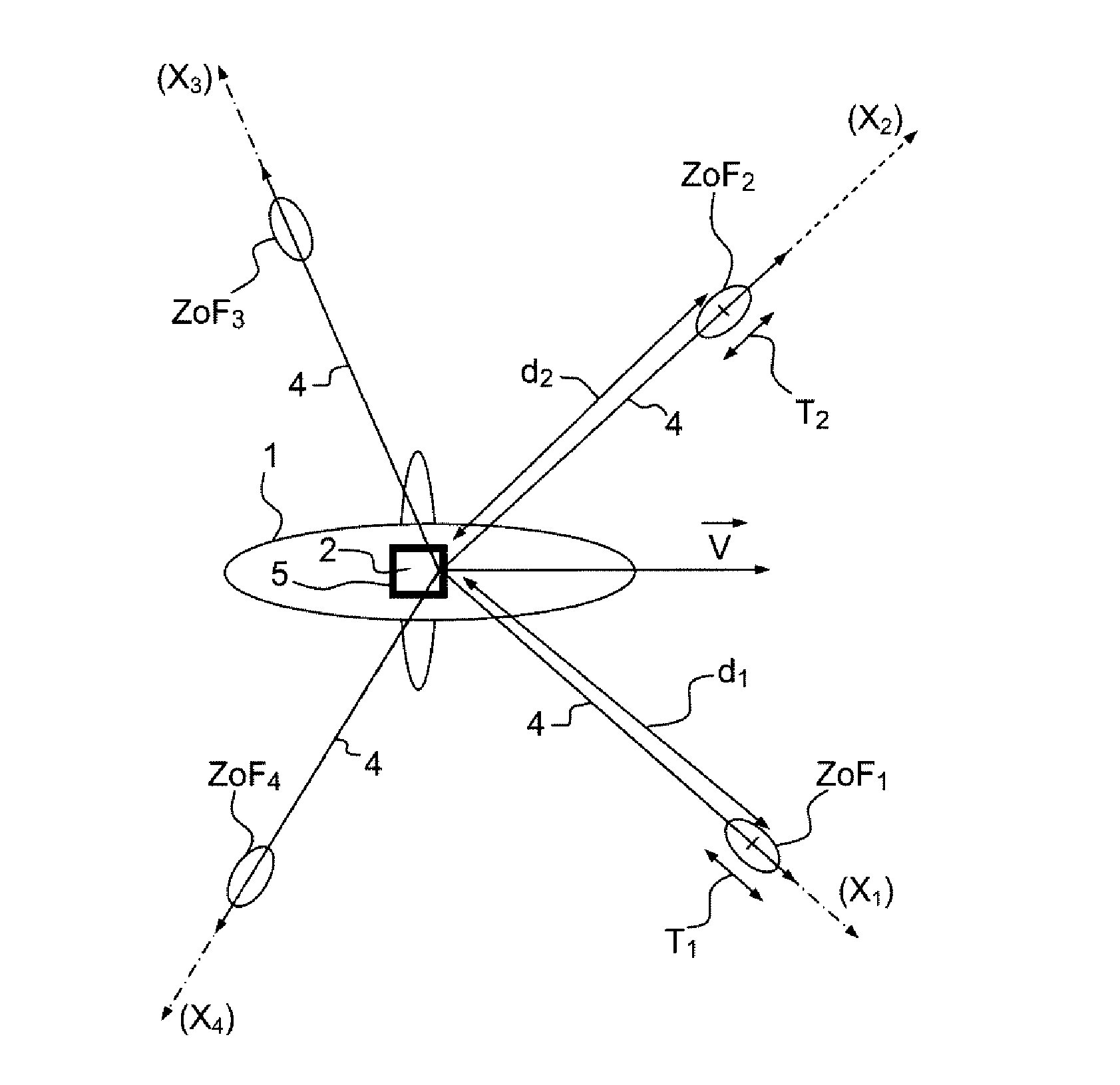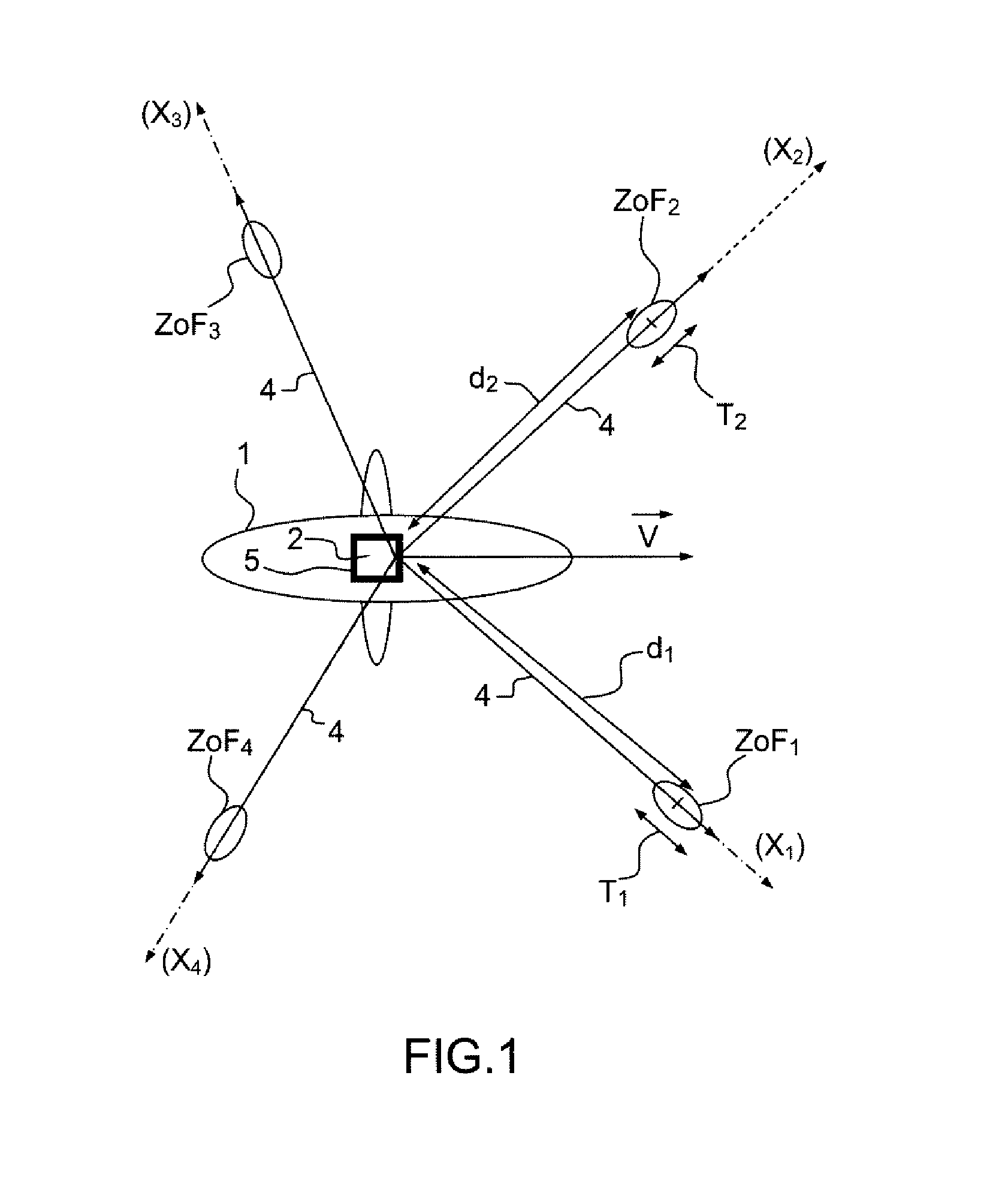Method of measuring the velocity of an aircraft by laser doppler anemometry
- Summary
- Abstract
- Description
- Claims
- Application Information
AI Technical Summary
Benefits of technology
Problems solved by technology
Method used
Image
Examples
first embodiment
[0086]In a first embodiment according to the invention, the velocity vector {right arrow over (V)} is chosen by implementing the method described below. One or more lines on each of the line-of-sight axes X1, X2, X3, X4, are selected. A line is identified when it satisfies a predetermined line selection criterion. A line selection criterion may consist in identifying a line when the amplitude of the spectrum of the signal exceeds a predetermined threshold S. The spectrum is filtered by an operator matched to the expected signal, for example by a Gaussian having the characteristics corresponding to the expected turbulence of the mass of air.
[0087]A first line is identified at the frequency at which the amplitude of the filtered spectrum is a maximum and above the threshold S. The next line is determined by the same method after having removed, from the spectrum, a frequency range lying around the frequency of the first identified line. The line detection procedure stops when there ar...
second embodiment
[0119]In other words, the second embodiment amounts to selecting base axes that are line-of-sight axes on which at least one line has been identified and to constructing candidate vectors from the identified lines on these base axes.
[0120]In this embodiment, the calculation axes are the line-of-sight axes. The candidate vectors are projected on all the line-of-sight axes and an expected signal is optionally ascribed to each projection. Next, the consistencies CON of the candidate vectors are calculated, these being the products, effected on all the line-of-sight axes, of the individual consistencies of the vectors on each line-of-sight axis. The individual consistencies are calculated in the same way as in the first embodiment. The measured velocity vector is then obtained by carrying out a likelihood analysis optionally preceded by a weighting of the consistencies similar to the analysis carried out in the first embodiment.
[0121]In the first two embodiments, the candidate vectors a...
third embodiment
[0123]In a third embodiment according to the invention, the method is based on the fact that the velocity vector {right arrow over (V)} of the aircraft does not vary suddenly. The candidate velocity vectors {right arrow over (V)}c at a given instant t lie within an uncertainty volume, the boundary of which is defined according to the calculated velocity vector at the previous instant t−Δt. For example, the uncertainty volume is estimated from at least one previous velocity measurement by propagation, for example using a Kalman filter.
[0124]As a variant, the uncertainty volume is also estimated from information about the dynamics of the carrier (for example from inertial information delivering low-noise measurements). Thus, a better estimate of the uncertainty volume is obtained.
[0125]The uncertainty volume is divided into candidate velocity vectors, for example by means of one of the following two conventional methods:[0126]random sampling in the uncertainty volume (“particulate” me...
PUM
 Login to View More
Login to View More Abstract
Description
Claims
Application Information
 Login to View More
Login to View More - R&D
- Intellectual Property
- Life Sciences
- Materials
- Tech Scout
- Unparalleled Data Quality
- Higher Quality Content
- 60% Fewer Hallucinations
Browse by: Latest US Patents, China's latest patents, Technical Efficacy Thesaurus, Application Domain, Technology Topic, Popular Technical Reports.
© 2025 PatSnap. All rights reserved.Legal|Privacy policy|Modern Slavery Act Transparency Statement|Sitemap|About US| Contact US: help@patsnap.com



